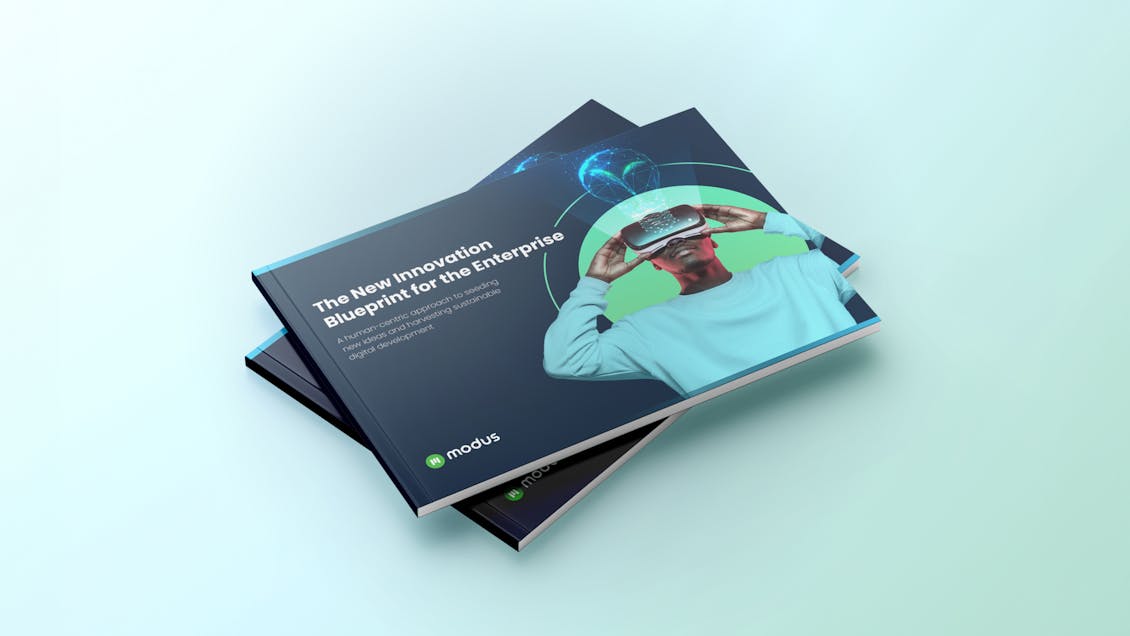Make way for innovation in the enterprise

How much room should be made for innovation in the enterprise? As "mushroom" as possible!
The following is an excerpt from our eBook, The New Innovation Blueprint for the Enterprise. Download the full version here.
The words “human” and “humor” both trace back to the Indo-European root, “ghom,” or “humus,” meaning earth or ground. This etymology is enlightening if we think about the common thread of being born of this earth, and how important it is to be able to laugh at ourselves (“humility” is part of this root, too) in order to face life’s realities.
During the pandemic, I spent many hours walking through the woods, looking up at the trees, listening to the birds chirping. I even launched a podcast, “Wild Talk,” featuring conversations that all take place outdoors. Nature humbles us, and reminds us of our place in the grand scheme of things.
Meanwhile, underfoot — in forests, gardens, even deserts — is a rich and complex network called mycelium, a fundamental building block of healthy soil. These fungi roots branch throughout the earth, in patterns that mimic the synapses of the brain, intertwining with plants and trees, moving carbon and nutrients. Without this critical layer, entire ecosystems would collapse.
When I approach our clients and partners to implement an innovation program, one of the first signals I look for is healthy soil. What I mean by that is, what is in place to support innovation within the organization? How are resources, people, processes, and knowledge connected? Just as the mycelium colonies decompose organic matter, a sustainable innovation culture will be generative. You can take lessons learned from “failed” initiatives and compost them into valuable learnings or components. You can curate a rich environment in which seeds can sprout and fruit can grow and ripen.
Now that we’re out of the pandemic storm, we’ve adjusted to a paradigm shift. Research shows that for many organizations, productivity has not suffered with remote work, but innovation has. While Slack, Zoom, and online collaboration tools keep us focused and in constant communication, studies show that we’re working with fewer people under stressful conditions that can lead to burnout. It’s not enough to say that your organization is “doing innovation.”
Innovation requires trust. To truly feel free to exchange ideas, people need the psychological safety that allows for vulnerability. We’ve found that introducing humor — from improv comedy sessions to silly board games — early in the creative process opens the mind for vigorous brainstorming. There’s scientific evidence behind this too — adding opportunities for laughter to your innovation teams and events can improve the outcome by as much as 37 percent¹.
At Modus, we’re passionate about transforming organizations at the root, collaborating in that space between idea and reality, and delivering better experiences for humans. I hope you find this blueprint a useful resource as you evolve your innovation program.
— Jay Erickson
Partner, Chief Innovation Officer
What does it mean to be an innovative enterprise today?
As a buzzword, “innovation” gets thrown around a lot these days. So much so that it’s hard to know what we’re really talking about when we say it. Merriam Webster unpacks the word simply: “the introduction of something new.”
In business, innovation isn’t just about inventing new stuff — your products and services must be customer-centric or employee-centric to be of value. And today, both the customer and employee mindset have shifted. Examples abound of how the enterprise accelerated digital transformation during the whirlwind disruption of the past few years. Video conferencing became ubiquitous; wellness has been prioritized, particularly in the form of meditation apps, Pelotons, and smartwatches; and we’ve witnessed the triumphant return of the QR code.
A global survey by McKinsey on digital strategy showed that enterprises accelerated digitization, on an average, by three to four years during the pandemic. Moreover, the share of digitally enabled offerings in their portfolios accelerated by a staggering seven years.
This advancement has been accompanied by volatility in the economy, armed conflicts, societal upheaval, supply chain vulnerabilities, climate change — essentially, a state of uncertainty is the new normal. As a result, ESG (Environmental, Social, and Governance) topics have emerged as critical issues for organizations of all sizes.
All signs point to the need for companies to shift from “survival mode” — executing critical, short-term fixes — and focus on thriving. By embracing this moment to reset and reinvest in core competencies, drive operational efficiencies, and produce future-forward initiatives, organizations can design themselves to be adaptable and resilient.
In 2024, artificial intelligence is the largest expenditure for enterprise technology budgets, according to CNBC. The modern enterprise depends on the agility of its development teams (both in-house and supplemental) to execute new concepts that create a competitive advantage. However, with new products and services rolling out at a constant pace, developers are reporting that they’re having a hard time keeping up with the increase in requirements, expectations, and business demands.
A 2022 global survey of IT decision-makers found that the top challenges facing developers include difficulty meeting deadlines and agility requirements (42 percent) and being asked to do too much with too little time (40 percent). Innovation post-pandemic will be very different from what it was pre-pandemic. With financial and talent resources likely to be constrained, organizations must reimagine innovation for value and relevance.
And with an increasingly complex IT environment, it can be difficult for technology teams to perform as the innovation engines that their organizations require. Success requires a holistic approach bridging practices, technology, and culture that supports an environment that is able to scale quickly with the business.
How can organizations manage rapid adoption of new technologies effectively and efficiently?
Sustainable development requires repeatable processes grounded in a human-centered approach. Any organization looking to thrive and grow needs to build capability and culture for a healthy pace of innovation. It takes a particular mindset and clear decision-making process to effectively translate a novel idea into an innovation with impact.
At Modus, we have more than two decades of experience helping large organizations like Johnson & Johnson, ADP, and Moody’s break down silos to introduce more human-centric strategies, products, and processes. By introducing more efficient ways of working, we help our clients transform technology teams from cost centers into centers of innovation. The results? Accelerated time to market, improved collaboration, and more reliable productivity.
While there’s no one-size-fits all methodology for innovation, in this playbook, we’ll unpack several of the formulas we use to guide technology leaders as they strive toward innovative product development that is both sustainable and customer-obsessed.
1 Karuna Subramaniam, John Kounios, Todd B. Parrish, and Mark JungBeeman, “A brain mechanism for facilitation of insight by positive affect,” Journal Of Cognitive Neuroscience, March 2009.

